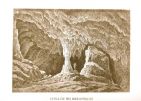
From Alaró to Raixa
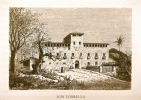 "The next town in the mountains’ foothills towards Alaró is Bunyola, though hidden in a valley. To reach it, we quickly turn to the west at the base of the hill from the path leading from Alaró to Consell. Passing next to the well-tended Mainou de Puigdorfila and Arboçar, we reach Son Torrella where a path behind the one descending to Coanegra takes you to the neighboring Santa María, crossing first through olive and carob tree groves and later almond and fig trees. Son Torrella is a majestic building, solid and very beautiful, with octagonal pilasters supporting the eave, balconies with wrought iron and a half-point arch, above which a type of tower rises up. A large hall with ribbed ceiling leads us to the pretty patio with a well in the center. There are four segmental arches on the long sides and three on the shorter sides, all atop round, rustic columns.
"The next town in the mountains’ foothills towards Alaró is Bunyola, though hidden in a valley. To reach it, we quickly turn to the west at the base of the hill from the path leading from Alaró to Consell. Passing next to the well-tended Mainou de Puigdorfila and Arboçar, we reach Son Torrella where a path behind the one descending to Coanegra takes you to the neighboring Santa María, crossing first through olive and carob tree groves and later almond and fig trees. Son Torrella is a majestic building, solid and very beautiful, with octagonal pilasters supporting the eave, balconies with wrought iron and a half-point arch, above which a type of tower rises up. A large hall with ribbed ceiling leads us to the pretty patio with a well in the center. There are four segmental arches on the long sides and three on the shorter sides, all atop round, rustic columns.
The estate also has domed stables, a “tafona” flourmill with four beams, two animal-drawn mills and a small watermill. The interior of the house encloses fairly spacious but modest rooms. To the left of the entrance is the small chapel with a ribbed ceiling divided into three sections. More black poplars and some elms accompany the course of the Torrent de Son Torrella, its banks covered by lush vegetation.
The path continues along the Torrent de Coanegra on the left side of the fairly wide valley surrounded by hills populated in part by olive trees and in part by pines. To the right is a sheer rocky wall, reddish in color and crowned by pine trees: Es Penyal Roig de Son Agulla. All the “possessions” estates we come to after Son Torrella have a watermill. On the other side of the path we find the great Son Oliver house with its large half-point arch portal. A stone bridge crosses the stream here next to which a splendid garden of fruit trees, walnut and elm trees and numerous prickly pears stands out. The valley winds along the base of the outcroppings and reddish escarpments of Penyal de Son Guitart, its slope lined with terraces. We pass by Son Roig in an area where the winding torrent is once more closed off by walls of rock. Orange tree groves abound in the area. A few steps farther and we come to Can Milio, surrounded by black poplars, walnut trees and elms. Some exuberant Holm oaks raise their rounded crowns above them, and we now find ourselves in the so-called Forn de Déu (God’s oven).
We then follow the stream bed, its sides framed by olive trees at the base and pine trees higher up. Meanwhile, the valley widens towards the area known as Es Racó des Freu.
Going through the pass which opens towards the valley of Orient, we finally reach Sa Comuna de Bunyola. The vegetation all around is truly lush: strawberry beds, heather, junipers and other bushes abound here in large numbers and with great vigor. We come to the Sa Comuneta house, inhabited once by a gentleman. From here, the path begins its descent to the green valley of Orient after first crossing through a dense grove of Holm oaks and crossing over a picturesque little bridge over the stream with rushing water.
If we begin our journey once more from Son Torrella and head to the west towards Bunyola, to our left we see Son Canals, a house with a half-point arch doorway and beautiful neighboring orange trees. From here we immediately come to Puig Gros de s’Estremera Vella, a notable hill which, on the part towards the plain, is lush, full of olive and carob trees, while some pine trees are on its east side.
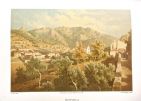 Up the valley we come to some farmhouses with small gardens of prickly pears and peach trees attacked by climbing vines. We can also see the town of Bunyola, surrounded by hills. It has 1,608 inhabitants. The town’s houses, 438 in number, seem more spread out, though the largest group is found on the eastern side of the valley, attached in part to the hill called Es Castellet. This explains the numerous small stepped streets paved with small stones. From the tallest part of the town, populated by prickly pears, we can enjoy a beautiful view over the Palma and Bellver roadstead. The houses are small, the majority consisting of two stories: 297 total. Some have three stories, 114; and only 27 have one. Many have been whitewashed, with a half-point arch portal and unerring window sill sticking out. Some have the well-known trailing vine. At the end of Carrer Mampostería, next to the plaza, is an old house with Renaissance-style decoration. The church, its roof rising to 233.38 m above sea level, is simple externally though richly adorned inside, with a Gothic vault and five elaborate side chapels. There is a gallery above the entrance. The main altar chapel is shaped like a niche and it has a vaulted ceiling.
Up the valley we come to some farmhouses with small gardens of prickly pears and peach trees attacked by climbing vines. We can also see the town of Bunyola, surrounded by hills. It has 1,608 inhabitants. The town’s houses, 438 in number, seem more spread out, though the largest group is found on the eastern side of the valley, attached in part to the hill called Es Castellet. This explains the numerous small stepped streets paved with small stones. From the tallest part of the town, populated by prickly pears, we can enjoy a beautiful view over the Palma and Bellver roadstead. The houses are small, the majority consisting of two stories: 297 total. Some have three stories, 114; and only 27 have one. Many have been whitewashed, with a half-point arch portal and unerring window sill sticking out. Some have the well-known trailing vine. At the end of Carrer Mampostería, next to the plaza, is an old house with Renaissance-style decoration. The church, its roof rising to 233.38 m above sea level, is simple externally though richly adorned inside, with a Gothic vault and five elaborate side chapels. There is a gallery above the entrance. The main altar chapel is shaped like a niche and it has a vaulted ceiling.
In the valley of Bunyola, around the town, there are large numbers of gardens with peach and walnut trees, in addition to bitter orange trees, forming thick foliage at the base of the town and in the valley. The conical hill overlooking Bunyola is called Es Castellet. A presumably Moorish wall climbs up it, though it is clearly more modern. A partially walled path climbs up between olive groves and vineyards and, after steps carved into the rock towards the summit, you come to a wall surrounding it, 175 cm thick towards the valley and 125 cm on the Bunyola side. Large rocks form the corners of this parapet which, towards the town and like a natural cornice, present four large steps carved into the rock. From above is a complete panoramic view of Bunyola and its surroundings.
From Bunyola we can begin a pretty excursion to the neighboring Comuna.
We pass through Comellar d’En Cupí all along a slope of reddish cliffs littered with caves: the first is known as Sa Cova Gran des Comellar des Racó de Can Fil, while the second one on the second prominent mountain is Sa Cova de Son Creus. In the aforementioned Comellar d’En Cupí through which the path passes with effort, there are first almond trees followed later by pines and some solitary Holm oaks. Cova Gran cave, its wide entrance allowing us to already see the stalactites in its interior, at night serves as shelter for the numerous wild doves in the area.
 The valley extends towards Son Creus, and the winding path climbs amongst pine trees and bushes through the so-called Part d’Amunt des Grau. Here there is a type of plain where a dense pine grove suddenly leads to a ravine through which the path descends sharply to border later around a lime oven which a large pine tree and small “aljub” cistern for sheep seemingly protect. Strawberry beds and Holm oaks have taken over this spot. Then, a shady path opens up in which the silence is barely broken by the occasional call of a cuckoo.
The valley extends towards Son Creus, and the winding path climbs amongst pine trees and bushes through the so-called Part d’Amunt des Grau. Here there is a type of plain where a dense pine grove suddenly leads to a ravine through which the path descends sharply to border later around a lime oven which a large pine tree and small “aljub” cistern for sheep seemingly protect. Strawberry beds and Holm oaks have taken over this spot. Then, a shady path opens up in which the silence is barely broken by the occasional call of a cuckoo.
Upon reaching the tallest summit, called Na Marit, at 666.76 m above sea level and with some pine trees, the view around us is certainly extraordinary.
Another tortuous and rocky path takes another route towards the town of Orient found in the mountains. To get there, we have to leave Bunyola via Carrer de la Síquia.
Next to the road, at the bottom of the valley, the large grove of orange trees in Can Grau stands out with its perfectly lined up trees of fairly large size.
Crossing the dry streambed, the path takes five curves on the other side of the hill which is also lined with terraces and planted with olive and carob trees.
Crossing the streambed once more, now to our right, we have a view of a broader valley on whose left side is the picturesque spot occupied by the Son Creus house semi-hidden by ivy.
In the area of the valley known as Camp d’Honor for the estate there, we see the facade of the large house with six windows painted yellow, with the landlord’s old house at its feet. An isolated, conspicuous hill stands out.
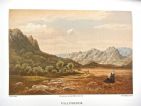 From Honor, a new road climbs up from a small hill along twelve curves. The surrounding is covered by heather and beautiful Holm oaks. Once on top of Coll d’Honor hill, we have a magnificent view of both sides as well as the entire valley we have just left behind and the one opening up next, the valley of Orient. A number of well-defined and easy curves follow. The path descends to the valley of Orient crossing through dense pine groves interspersed with some louquats, numerous Holm oaks and lush strawberry beds.
From Honor, a new road climbs up from a small hill along twelve curves. The surrounding is covered by heather and beautiful Holm oaks. Once on top of Coll d’Honor hill, we have a magnificent view of both sides as well as the entire valley we have just left behind and the one opening up next, the valley of Orient. A number of well-defined and easy curves follow. The path descends to the valley of Orient crossing through dense pine groves interspersed with some louquats, numerous Holm oaks and lush strawberry beds.
 The forests lining the edges of the valley, in particular, on the hills to the right, are amongst the most dense and vigorous in these mountains. To the right we also see the house of the Possessió de Ca Na Ferrera y Son Perot. It’s surrounded by bitter orange tree groves amongst which the owner’s house is currently being built next to a great spring.
The forests lining the edges of the valley, in particular, on the hills to the right, are amongst the most dense and vigorous in these mountains. To the right we also see the house of the Possessió de Ca Na Ferrera y Son Perot. It’s surrounded by bitter orange tree groves amongst which the owner’s house is currently being built next to a great spring.
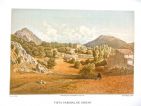 Orient, a town dependent on Bunyola 11.1 kilometers away, has 208 inhabitants. It barely consists of a church and some houses spread out amongst the fields, in addition to a small group of houses to the northeast, on top of a hill populated by the most lush and vigorous Holm oaks I have ever seen. They’re separated from the top where the church is by a small valley occupied by fruit trees and reeds primarily. There are 38 houses total. The church has a rectangular door with the sign of Jesus in the lintel and a simple rosette. The interior consists of a barrel vault ceiling held up by two half-point arches, one of which delimits the main altar chapel. There are also two side chapels similar in style to the main nave. It is all made of solid rock. Above the main entrance is a gallery with a small organ. The altar in the main chapel bears the date, 1686.
Orient, a town dependent on Bunyola 11.1 kilometers away, has 208 inhabitants. It barely consists of a church and some houses spread out amongst the fields, in addition to a small group of houses to the northeast, on top of a hill populated by the most lush and vigorous Holm oaks I have ever seen. They’re separated from the top where the church is by a small valley occupied by fruit trees and reeds primarily. There are 38 houses total. The church has a rectangular door with the sign of Jesus in the lintel and a simple rosette. The interior consists of a barrel vault ceiling held up by two half-point arches, one of which delimits the main altar chapel. There are also two side chapels similar in style to the main nave. It is all made of solid rock. Above the main entrance is a gallery with a small organ. The altar in the main chapel bears the date, 1686.
Crossing through a pass, we enter the valley of Coma-Sema, dominated by Puig d’Amós and Sa Muntanya de Franquesa. Above these still is Puig de Sa Peta.
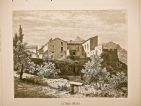 The house is large and forms a picturesque image with its open “clastra” at the front and its two wings. The main part of the building, its attic held up by eight columns, has a half-point arch portal. The lintel bears the names Jesus and María, the Coma-Sema coat of arms and the date, 1648. In the interior we can read the date, 1688, and, on the bell, 1718.
The house is large and forms a picturesque image with its open “clastra” at the front and its two wings. The main part of the building, its attic held up by eight columns, has a half-point arch portal. The lintel bears the names Jesus and María, the Coma-Sema coat of arms and the date, 1648. In the interior we can read the date, 1688, and, on the bell, 1718.
Next to the house’s entrance is a trough under the shade of a walnut tree and not far from a watermill and some auxiliary buildings. Farther up is a “safareig” basin.
 In front is Puig de Ses Meravelles with its sharp shelves covered in ivy and where we find the mouth of the impressive cave giving it its name. Opposite is Puig de l’Ofre. The cave’s opening in the shape of a natural ogive is semi-hidden by thorn bushes and is very spacious. Some steps descend to the back. Down a steep climb and low ceiling, we come to a type of atrium with regular and slightly inclined floor. To the right is a small opening, Sa Boca des Forn, which you can descend, noting at the same time how the air freshens outwardly. To the right we find some formations known as Els Orgues, and to the left is the main chamber with flat ceiling and abundant broken stalagmites. Some, however, are intact, those on the top right resembling monstrous stony cauliflowers where there is an excavation to which a ramp leads and that the lime, thread-shaped formations seem to cover with a veil. In the back of this cavity is a large, column-like stalagmite with a small chamber behind it full of stalactites.
In front is Puig de Ses Meravelles with its sharp shelves covered in ivy and where we find the mouth of the impressive cave giving it its name. Opposite is Puig de l’Ofre. The cave’s opening in the shape of a natural ogive is semi-hidden by thorn bushes and is very spacious. Some steps descend to the back. Down a steep climb and low ceiling, we come to a type of atrium with regular and slightly inclined floor. To the right is a small opening, Sa Boca des Forn, which you can descend, noting at the same time how the air freshens outwardly. To the right we find some formations known as Els Orgues, and to the left is the main chamber with flat ceiling and abundant broken stalagmites. Some, however, are intact, those on the top right resembling monstrous stony cauliflowers where there is an excavation to which a ramp leads and that the lime, thread-shaped formations seem to cover with a veil. In the back of this cavity is a large, column-like stalagmite with a small chamber behind it full of stalactites.
 From Coma-Sema the Camí del Bosc path starts amongst numerous hawthorns and junipers. It then runs through the valley at the base of Sa Franquesa and reaches Puig d’Amós over a forest-covered hollow. To the right, the valley extends to Solleric with the hills of Alcadena and Castell d’Alaró. Standing out here is the presence of a large Neolithic sepulcher (“talaiot”). The entrance is found on the part facing Freu or the wide pass to the valley and two unusually large Holm oaks known respectively by the names, Na Torta, the first one, and Es Collet, the second.
From Coma-Sema the Camí del Bosc path starts amongst numerous hawthorns and junipers. It then runs through the valley at the base of Sa Franquesa and reaches Puig d’Amós over a forest-covered hollow. To the right, the valley extends to Solleric with the hills of Alcadena and Castell d’Alaró. Standing out here is the presence of a large Neolithic sepulcher (“talaiot”). The entrance is found on the part facing Freu or the wide pass to the valley and two unusually large Holm oaks known respectively by the names, Na Torta, the first one, and Es Collet, the second.
As already indicated, you reach the road to Sóller in just a few minutes from Bunyola.
The Raixa house is found at the base of a soft slope occupied mostly by gardens. As it’s found slightly higher than the plain around it, the house overlooks it almost completely. Next to the entrance is a cistern, and an old hackberry stands out in the inner patio. Nothing stands out from the building’s exterior, but it has a beautiful hall with ten half-point arches on rustic pilasters. It opens to the exterior with views of the opposite hill lined in terraces.
The collection of antiques is found on the first floor, and, already at the entrance we can read numerous inscriptions engraved in the wall. In the hall with not a few statues and to the right is the bust of the founder next to the door. There are some truly beautiful statues amongst the others. Especially noteworthy is the one identified as number 23 of Dyonisius, as well as numbers 32, 22 and 16.
At the top of the hill occupied by the garden is a small house built in 1854 with a side terrace from which there is a view of all the gardened area, the “possessió” estate house below and the steep foothills on the other side belonging to different owners.
The garden also extends on the other side of the house, reaching into the plain a bit. It connects to the garden already described by means of a complicated labyrinth, confusing hedges and a type of natural room created by the lush ivy. The abundance of water, the beauty of its location, the careful artificiality of the gardens and the proximity to Palma make Raixa one of the prettiest estates on the entire island. Not far is Raixeta, also belonging to the Count of Montenegro, and farther still, Biniatzar, another of the old farmsteads from the time of the Conquest.
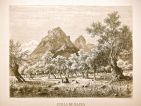 We return to the road. In addition to the two hills of Raixa, on this side we also see another two separated by a steep pass, and a third solitary one in the middle of the plain. The three, very steep and barren, are known as the Colls de Raixa hills."
We return to the road. In addition to the two hills of Raixa, on this side we also see another two separated by a steep pass, and a third solitary one in the middle of the plain. The three, very steep and barren, are known as the Colls de Raixa hills."
Archduke Ludwig Salvator of Austria. Las Baleares por la palabra y el grabado. Majorca: The island. Ed. Sa Nostra, Caja de Baleares. Palma de Mallorca. 1982.











